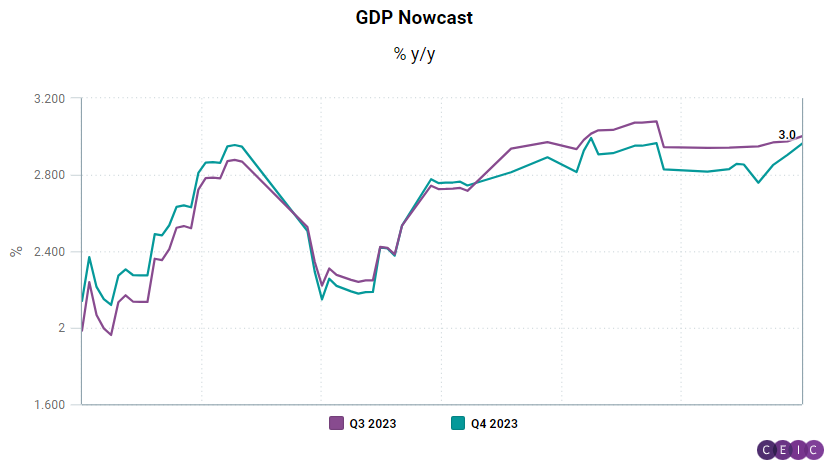
Brazil's economic growth saw a slight slowdown in Q3 2023, according to high frequency and alternative data as of late September. CEIC’s proprietary GDP nowcast points to 3% y/y growth in Q3 2023, which, if materialized, would mean a slowdown from the 3.4% y/y growth rate in the previous quarter. Further, the Brazilian economy is projected to expand at a similar rate in Q4 (3% y/y), which would bring the full-year 2023 growth to 3.3%. This is slightly above the 3.2% y/y forecasted by the Brazilian federal government and the Organization of Economic Cooperation and Development (OECD), and 0.35pp higher than the 2.92% y/y median markets' expectation as of September 25.

Domestic demand will likely set the pace of the economy in the remainder of 2023, as the agricultural production and exports - that pushed up the GDP growth in the first semester - will face a seasonal downturn in H2. The declining capacity utilisation in manufacturing and the deacceleration of the industrial activity index weighed on CEIC’s proprietary GDP nowcast. Those two variables cut 0.34 and 0.13 percentage points (pp), respectively, from the Q3 GDP nowcast. On the other hand, the core inflation keeps following a downward trend, signalling that the central bank could further cut the benchmark SELIC rate. In July, the core inflation index contributed 0.17pp and 0.23pp on the GDP nowcast estimates for Q3 and Q4, respectively. In August, the higher traffic of heavy vehicles on highways provided the biggest contributions to these forecasts, of 0.23pp and 0.45pp, respectively.

The CEIC Leading Indicator for Brazil reaffirms the expectations of robust growth at the end of 2023 and into 2024. The composite index, which predicts the turning points of the business cycle by two to three quarters in advance, hit a two-year high of 102.5 in August - higher than the 100-mark, which indicates the long-term trend. The main contribution came from index measuring the construction companies’ expectations to purchase inputs, which stood at 55.7, signalling stronger demand for construction and real estate in the coming months.
The CEIC Global Database provides access to a vast database where users can gain insight into the ever-changing dynamics of world economies.
.png?width=160&name=ceic-logo-Vector%20logo%20no%20tagline%20(002).png)
